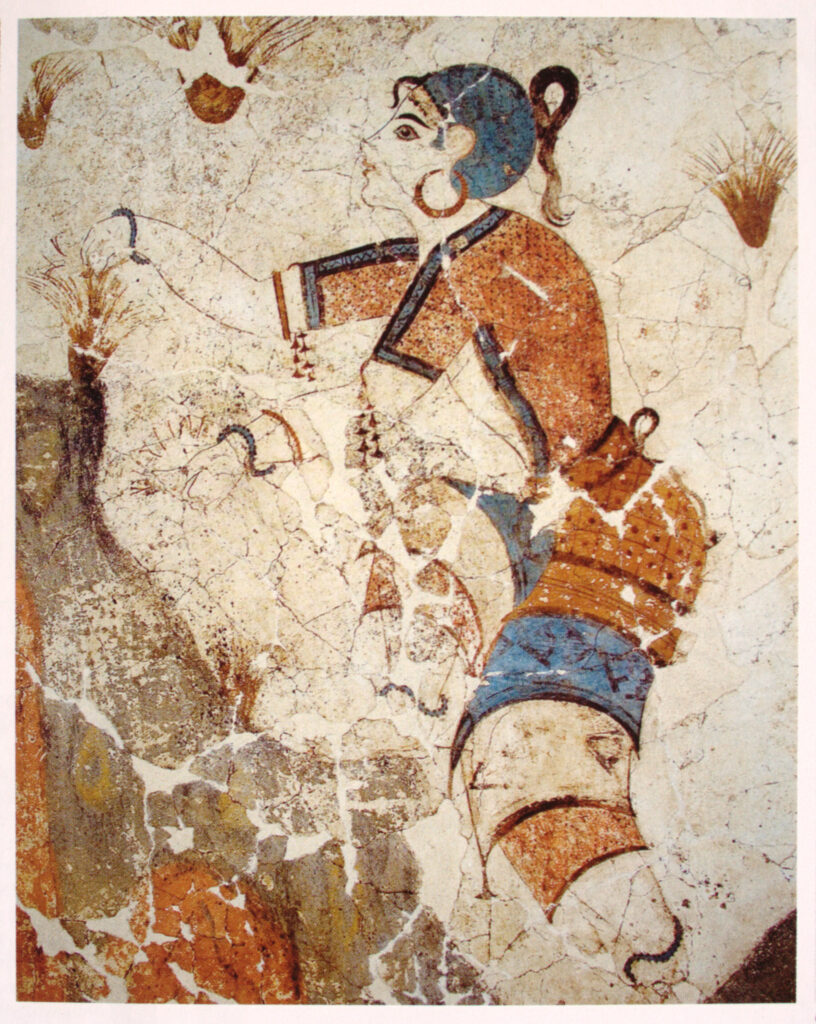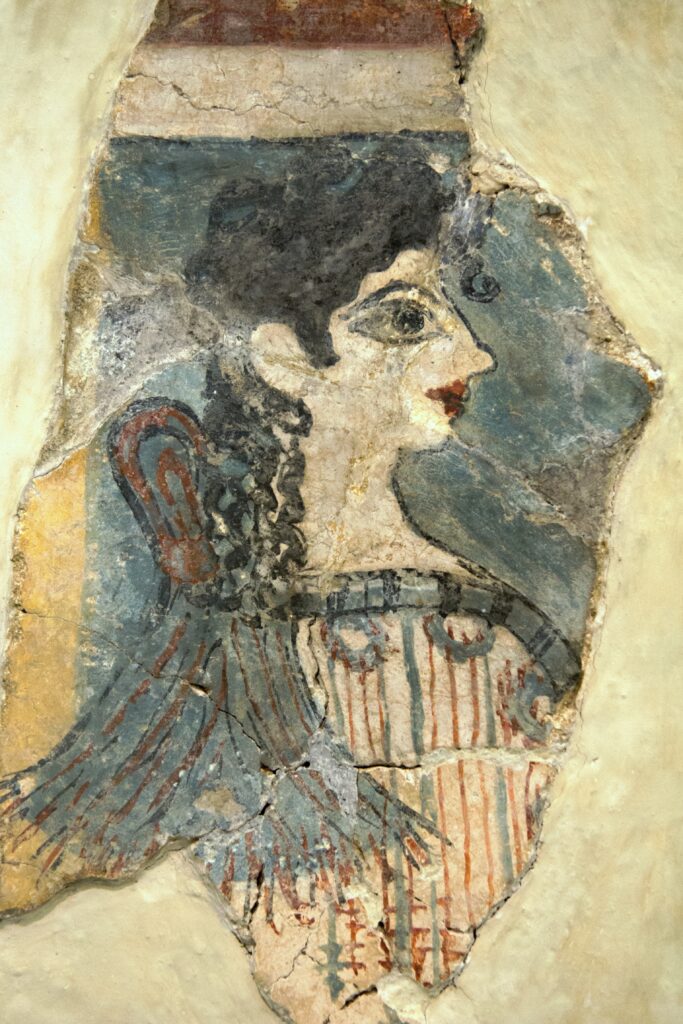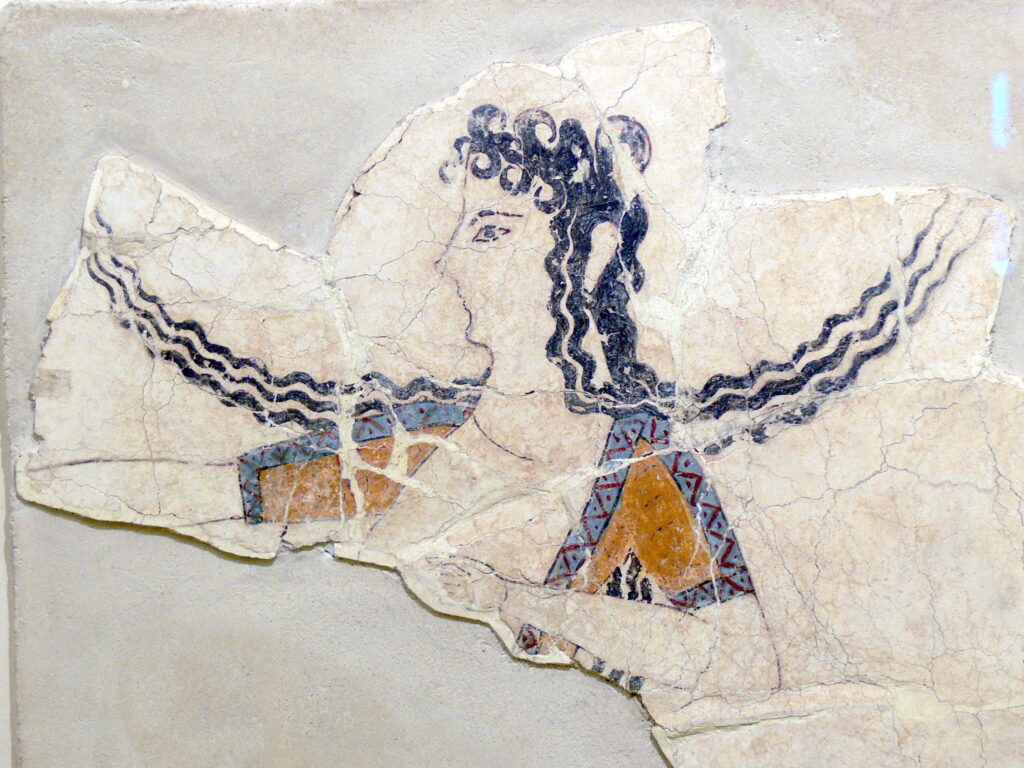2020.10.02 | By Gregory Nagy
§0. Over many weeks now I have been previewing, not yet reviewing, a heretofore unpublished work by Morris Silver, The Purpled World: Marketing Haute Couture in the Aegean Bronze Age. This work, by an economist whose vast learning includes an acute understanding of historical and archaeological approaches to the ancient world, has profoundly influenced my thinking about the Aegean Bronze Age, as he refers to it. I concentrate here on what Silver has to say overall about purple dye, derived from the gland of a kind of “shellfish,” the murex, and about yellow or saffron dye, derived from the stamen of the crocus plant. Like Silver, I am interested in the use of these purple and yellow dyes in the mass production—and marketing—of woolen textiles, fueled by a commensurate mass production of wool shorn from countless herds of sheep, in the Minoan-Mycenaean world of the second millennium BCE. The vast scale of such mass production and marketing, as Silver demonstrates, is of imperial dimensions. And the fashionable clothing made from the dyed woolen textiles was correspondingly imperial in prestige. As Silver also demonstrates, this prestige is ostentatiously advertised in Minoan-Mycenaean fresco paintings that picture a wide variety of charismatic female and male figures who are seen in the act of showing off the multicolored beauty of their fashionable wear. I say “multicolored” because yellow and purple are not the only colors that are featured in Minoan-Mycenaean haute couture: the varying technologies of decoction from the gland of the murex, as also the existing varieties of this kind of “shellfish,” belonging to the taxonomic family Muricidae, can produce blue and red as well as purple dye. For a salient example, I highlight the red and blue stripes adorning the skirt of the young lady in the fresco painting that I show here. In what follows, I will argue that such modulations from purple to red or to blue are comparable to the color-coding of the Peplos or Robe of the goddess Athena as pattern-woven for the festival of the Panathenaia during the attested centuries of the first millennium BCE.

§1. In Masterpieces of Metonymy (Nagy 2016|2015, hereafter MoM), I concentrate on two colors, purple and saffron yellow, in my analysis of descriptions, stemming from the ancient world, of the threading that went into the transverse pattern-weaving of the Peplos or Robe of Athena, which pictured the primal Gigantomachy or Battle of the Gods and Giants. For example, purple depicted the color of the blood shed by the giants (MoM 2§§82, 132), while yellow depicted the golden tip of Athena’s spear (MoM 2§132).
§2. But what about the colors red and blue? In ancient languages other than Greek, there is a clear distinction between red and blue as two different kinds of purple dye for wool. In Akkadian, for example, red from purple is argamannu while blue from purple is takiltu; correspondingly in Hebrew, red from purple is argaman while blue from purple is tekelet (MoM 2§132n140 via Lepschy 1998:54; more on Hebrew tekelet in Stieglitz 1994:48). In Greek, by contrast, the distinction between red and purple can in some contexts get blurred, as we see for example in the case of the myth about Porphuríōn ‘The Purple One’, king of the Giants (Pindar Pythian 8.12–13, Aristophanes Birds 1251, “Apollodorus” Library 1.6.1–2). This cosmic figure who shares with Athena a central place in the narrative of the Gigantomachy is the very embodiment of purple—as pattern-woven into the Peplos of Athena on the occasion of the quadrennial Panathenaia (MoM 2§133).
§3. But the color scheme was different in the pattern-weaving of the Peplos of Athena for the festival of the annual or Lesser Panathenaia that was held on every year other than the year of the quadrennial or Great Panathenaia. In this case, the dominant color of the threading was yellow, not purple. In what follows, I give an epitome (MoM 2§§135–141):
§135. I start with the name given to the king of the Giants as represented in the annual Panathenaic Peplos. Unlike Porphuríōn, the name of the purple king of the Giants in the quadrennial Panathenaic Peplos, the name of the corresponding Giant in the annual Panathenaic Peplos shows that he was threaded in yellow, not in purple.
§136. We learn from Aristotle (F 637 ed. Rose) that the festival of the annual or Lesser Panathenaia was aetiologized by way of a specialized myth that told of the primal killing of a Giant named Asterios or Astēr by the goddess Athena. These two names Asterios or Astēr are most revealing, since both forms derive from the noun astēr meaning ‘star’: so the Giant is a ‘Star’. The proper threading, then, for this shining Giant is not purple but yellow.
§137. Such a difference in the color schemes of the annual and the quadrennial Peplos can be correlated with another difference. Whereas the quadrennial Peplos was pattern-woven by professional male weavers, the annual Peplos was the work of specially selected non-professional female weavers (Nagy 2009|2008 4§206).
§138. Here I find it relevant to note that the peplos presented as an offering to the goddess Athena by the women of Troy at Iliad 6.295 is said to shine like an astēr ‘star’. I argue that the simile and the name are both cognate with a traditional iconographic narratology of star patterns woven into the Peplos of Athena at the Panathenaia (Nagy 2009 II§403 = 2010:288).
§139. The mark of femininity in the accentuation of yellow rather than purple threading can be seen in references to the color of saffron in descriptions of the annual Panathenaic Peplos. I am about to show one such description, which I have extracted from the Hecuba of Euripides. And, as we will see in this example, there is reason to think that the dominant yellow threading of the annual Peplos was correlated with a feminized pattern of avoiding the grim theme of bloodshed in war, by contrast with the dominant purple threading of the quadrennial Peplos.
§140. The example I have in mind here comes from a choral lyric passage in the Hecuba of Euripides. The dramatic time of this drama focuses on the grim aftermath of the Trojan War, and we are about to read words sung-and-danced by a chorus of captive Trojan women who are imagining their future as slaves living in the foreign lands of their Hellenic captors. If they are to be taken to Athens, they imagine, their work there will be the weaving of the Peplos of Athena. Although their bad fortune has transformed them into slaves, these Trojan women still think and behave like aristocrats. Even though they will be slaves of the Hellenes, these Trojan women retain their aristocratic charisma by pathetically imagining themselves in the act of performing a task traditionally performed by the aristocratic daughters of Athens. And that task is the weaving of the Peplos of Athena. Here is the women’s description of the Peplos—and of the colors to be pattern-woven into it:
|466 ἢ Παλλάδος ἐν πόλει |467 τὰς καλλιδίφρους Ἀθα|468 ναίας ἐν κροκέωι πέπλωι |469 ζεύξομαι ἅρματι πώ|470 λους ἐν δαιδαλέαισι ποι |471 κίλλουσ’ ἀνθοκρόκοισι πή |472 ναις ἢ Τιτάνων γενεάν, |473 τὰν Ζεὺς ἀμφιπύρωι κοιμί |474 ζει φλογμῶι Κρονίδας;
Or, in the city of Pallas [Athena], into [the texture of] the saffron-colored Peplos of Athena, shall I yoke beautiful horses to her chariot [harma], matching the beautiful vehicle, as I pattern-weave [poikillein] them [= the horses and the chariot] with threads colored by the blossoms of saffron, or [as I pattern-weave] the generation of Titans who were put to sleep [koimizein] by Zeus the son of Kronos with a lightning stroke that had fire flashing all around it?
Euripides Hecuba 466–474
§141. In this pattern-woven picture of Athena riding on a chariot drawn by horses, I argue, the dominant color of the horses together with their chariot is yellow. If this argument holds, then the flashing thunderbolt of Zeus would be yellow. And here the destruction of the Giants seems to be taking place without bloodshed, since they are ‘put to sleep’ by the radiant weapon of Zeus. If in fact the foregrounding of the luminous gods is pattern-woven in yellow, that is, in the color of saffron, then any purple in the background can now default to blue, matching the blue skies of a most successful cosmic outcome.


Bibliography
Lepschy, A. 1998. “Il colore della porpora.” In La porpora: realtà e immaginario di un colore simbolico; atti del convegno di studio, Venezia, 24 e 25 ottobre 1996, ed. O. Longo, 53–66. Venice.
Nagy, G. 2009|2008. Homer the Classic. Printed | Online version. Hellenic Studies 36. Cambridge, MA, and Washington, DC. http://nrs.harvard.edu/urn-3:hul.ebook:CHS_Nagy.Homer_the_Classic.2008.
Nagy, G. 2010|2009. Homer the Preclassic. Printed | Online version. Berkeley and Los Angeles. http://nrs.harvard.edu/urn-3:hul.ebook:CHS_Nagy.Homer_the_Preclassic.2009.
Nagy, G. 2016|2015. Masterpieces of Metonymy: From Ancient Greek Times to Now. Printed | Online version. Hellenic Studies 72. Cambridge, MA and Washington, DC. http://nrs.harvard.edu/urn-3:hul.ebook:CHS_Nagy.Masterpieces_of_Metonymy.2015.
Stieglitz, R. R. 1994. “The Minoan Origin of Tyrian Purple.” The Biblical Archaeologist 57:46-54.
